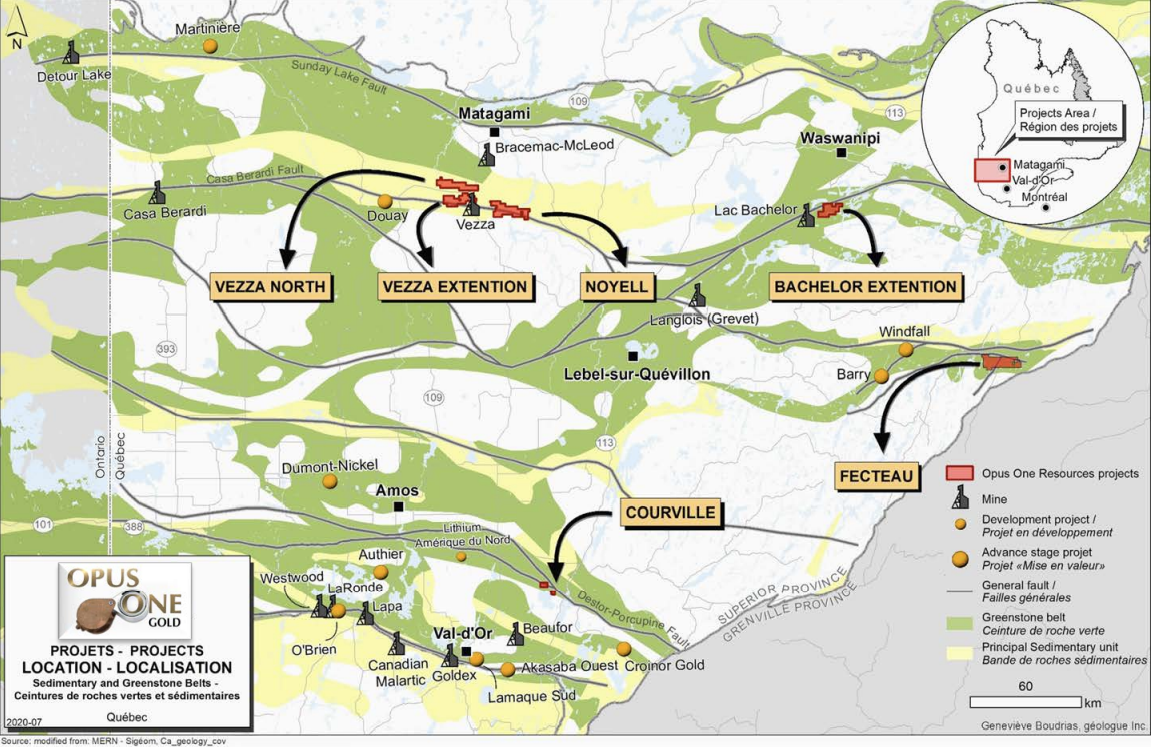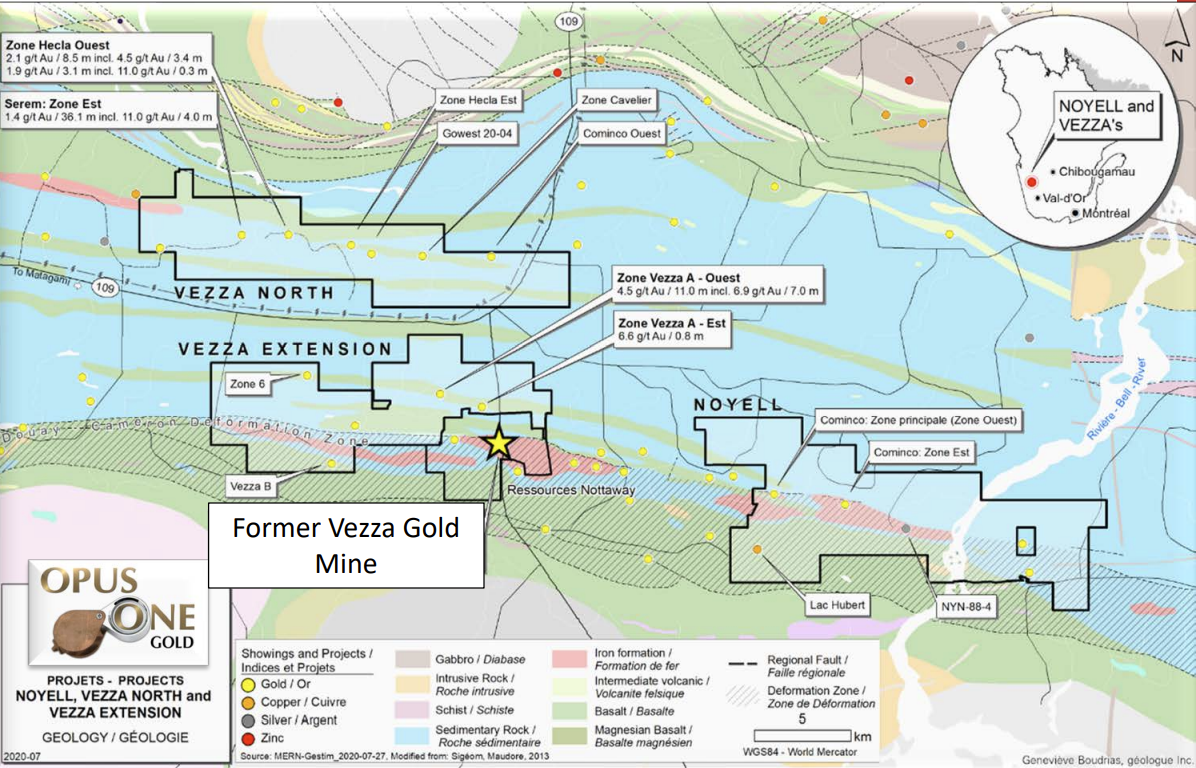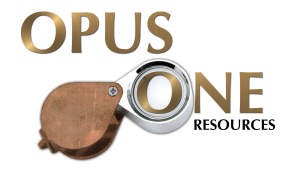The Vezza North property (100% owned by Opus One Gold) is located 27 km south of Matagami and 152 km north of the town of Amos. The property (60 claims, 3351 hectares) is entirely contained in the Harricana-Turgeon Belt, an Archean volcano-sedimentary and plutonic rocks assemblage that constitutes the northern part of the Abitibi Greenstone Belt.
The claims of the Vezza North project straddle the provincial Route 109 between Amos and Matagami within NTS sheet 32F12. Several logging roads and trails run through the property, providing easy access. Full infrastructure and experienced mining workforce are well-established nearby mining towns, such as Val d’Or, Malartic, Rouyn-Noranda, Lasarre, Amos, Matagami and Lebel-sur-Quévillon.
The Vezza North property is entirely contained in the Taibi Domain sediments, near the contact with the dominantly basaltic Orvilliers-Desmazures Domain. The Taibi Sedimentary Domain is composed of clastic sediments (sandstone, siltstone and minor mudstone) associated with a turbidite sequence. Mafic volcanic flows (basalt and andesite) and some pyritised rhyolitic tuffs horizons are intercalated in the sedimentary sequence, in a proportion of 10 to 20%. Basaltic and andesitic basalts strike N100°, with polarity towards north and dip from 70° to 75° towards south. They can reach several hundreds of metres in thickness. In more detail, the bedrock of Vezza North property is composed of argillites, siltstones, mudstones, sandstones and conglomerates. Tuff horizons of felsic to mafic composition are intercalated in the sediments. Numerous iron formations, mostly with magnetite, are intercalated in the sediments and tuffs. The occurrence of a conglomeratic band striking more than 15 km and which is associated with gold intersections represents the highlight of the property.
The Vezza North property contains the Casa-Berardi Nord/Cavalier deformation zone for over 14 km. These zones are roughly oriented east-west and dip steeply to the south. They seem to join at low angles in the west portion of the property and become subparallel more to the east.
The property hosts important gold showings, with Serem Zone East and Hecla Zone West being the two (2) most important. Best intersections are:
- 1.4 g/t Au over 36.1 m including 10.95 g/t Au over 4.0 m (A-20) less than 125 m from surface (Serem East Zone);
- 2.1 g/t Au over 8.5 m including 4.5 g/t Au over 3.4 m (200E-2) less than 110 m from surface (Hecla West);
- 1.9 g/t Au over 3.1 m including 11.0 g/t Au over 0.3 m (100E-1) less than 110 m from surface (Hecla West);
- 1.8 g/t Au over 4.0 m including (200E-1) less than 50 m from surface (Hecla West);
- 1.9 g/t Au over 3.5 m (A-04) less than 80 m from surface (Serem East Zone).
The mineralized zones of Serem East Zone and Hecla West Zone globally appear on the same deformation zone although in more detail, they are located in two (2) parallel levels about 250 m apart. These zones remain open laterally and 250 m below the surface. The showings of Vezza North property share several common features. They all contain quartz-carbonate veins with occasional tourmaline. Zones of disseminated gold and pyrite with no vein are observed locally, although with generally lower gold contents. Sulphide phases consist of pyrite and arsenopyrite. There is a strong correlation between Au and As content for almost all showings. Traces of sphalerite and occasional magnetite are present. In mineralized zones, ankeritisation and silicification are commonly observed as well as chloritisation and minor hematisation which may also occasionally occur.
Opus One Gold conducted the 2017 drill program in order to follow-up on priority targets, identified by compilation of historical works or by recent geophysical surveys. During the previous drilling programs several gold-bearing mineralized zones were associated with IP anomalies. The Hecla West Showing returned results such as 1.9 g/t Au over 3.1 m including 11.0 g/t Au over 0.3 m or 2.1 g/t Au over 8.5 m including 4.5 g/t Au over 3.4 m and the Zone Serem Est mineralized zone returned assay results such as 1.4 g/t Au over 36.1 m including 10.95 g/t Au over 4.0 m. The geophysical survey conducted by Adventure Gold in 2016 outline the western extension of the IP anomaly and the main purpose of this drilling program was, in addition to, establishing continuity of gold zones on the eastern part of the property, also to test local continuity beneath the existing Zone Serem Est and Hecla West showings.
Hole VZ-01 was drilled to test the continuity of both the #IPVNE-2 IP anomaly and a high mag on line 1600E. It intersected mainly andesite and andesitic basalts, and alternating units of iron formation and graphitic schists injected by numerous cm wide quartz veins with pyrite-pyrrhotite and chalcopyrite mineralization. Alteration consisted of near ubiquitous carbonatization and chloritization. Best result was 3 m of 0.16 g/t Au within graphitic schists containing up to 30% pyritic nodules
Hole VZ-02 was drilled to test the continuity of the Hecla West showing beneath historic holes 100E-1 (1.9 g/t Au over 3.1 m including 11.0 g/t Au over 0.3 m) and 200E-2 (2.1 g/t Au over 8.5
m including 4.5 g/t Au over 3.4 m) drilled by Hecla Mining Company in 1986 (GM 45379). It mainly cut a felsic to intermediate tuff unit moderately sericitized and silicified. Best results was 12.85 g/t Au over 0.5 m within a chloritized section and 1.725 g/t Au over 1.0 m within a quartz-carbonate stockwork containing locally up to 20% pyrite.
Hole VZ-03 was drilled to test continuity of the Zone Serem Est mineralized zone beneath historic hole 96-CA-A-20 (1.4 g/t Au over 36.1 m including 10.95 g/t Au over 4.0 m) drilled by Geonova Exploration in 1996 (GM 55917). It mainly intersected alternating units of wacke and argillite with 30m of polymictic conglomerates. About 34 m of polymictic conglomerates has been intersected and, as regionally described, the unit appears as a stratigraphic marker and is associated with some gold mineralization. Best result was 0.28 g/t Au over 2.5 m within a quartz vein rich mineralized zone containing up to 5% pyrite and arsenopyrite at the bottom contact of the conglomerates and the upper contact returned 0.14 g/t Au over 1.50 m.
In early 2022, Opus One Gold is performing an aerial high resolution magnetic survey over the entire property in order to obtain a better understanding of the property geology and generate new targets for a future drilling program.


